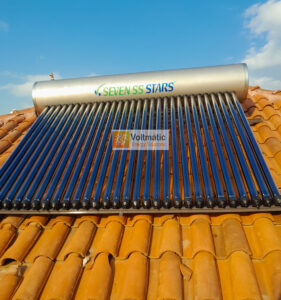Which Solar Water Heating System is Right for You?

As energy costs continue to rise, many homeowners and businesses are exploring renewable energy options, and solar water heaters are becoming a popular choice. Not only do they reduce electricity bills, but they also contribute to a greener planet by utilising clean, renewable solar energy. However, with various options available in the market, choosing the right solar water heater can be a challenge. In this guide, we’ll break down the types of solar water heaters, their benefits, and key factors to consider when selecting the best system for your needs.
Types of Solar Water Heaters
1.Flat Plate Collectors
Flat plate collectors are one of the most common types of solar water heaters. They consist of a dark absorber plate placed under a glass cover, which captures sunlight and converts it into heat. This heat is then transferred to the water running through pipes beneath the absorber plate.
Pros:
- Simple design
- Cost-effective
- Suitable for moderate climates
Cons:
- Less efficient in colder climates
- Can lose heat more quickly
2.Evacuated Tube Collectors
Evacuated tube solar collectors consist of rows of glass tubes. Each tube has an absorber inside that collects sunlight, with a vacuum-sealed outer tube that provides insulation, minimising heat loss. These are typically more efficient than flat plate collectors.
Pros:
- Highly efficient in both sunny and cloudy conditions
- Great for colder climates
- Longer lifespan
Cons:
- Higher initial cost
- Requires more maintenance
3. Thermosiphon Systems
Thermosiphon systems work by allowing water to circulate naturally between the collector and storage tank without the need for pumps. The solar collector is installed below the tank, and as water heats up, it rises into the storage tank. This type of system is generally more affordable.
Pros:
- Lower maintenance due to fewer moving parts
- Energy-efficient
- Affordable
Cons:
- Limited installation flexibility
- Requires installation on the roof
4. Active Solar Water Heating Systems
Active systems use electric pumps and controllers to circulate water through the collectors. These systems are more complex but offer better control and efficiency compared to passive systems like thermosiphon systems.
Pros:
- More efficient and effective in various climates
- Flexible in terms of installation options
- Provides hot water more consistently
Cons:
- Higher upfront cost
- More complex, leading to higher maintenance needs
Pressurised vs. Non-Pressurised Solar Water Heaters
- Pressurised Solar Water Heaters: Pressurised systems maintain water pressure similar to that of your plumbing system therefore providing a consistent flow of hot water. Therefore making them ideal for homes that need higher water pressure for showers, kitchen use, and multiple hot water outlets.
- Non-Pressurised Solar Water Heaters: Non-pressurised systems are less expensive and rely on gravity to deliver hot water. While they are more affordable, they are better suited for areas with lower water demands, such as small households or areas where water pressure isn’t a primary concern.
Factors to Consider When Choosing a Heating System
- Climate: If you live in a colder region, evacuated tube collectors are generally more efficient. However, in warmer areas, flat plate collectors or non-pressurised systems may be a more cost-effective option.
- Water Usage: Your household size and hot water demand will dictate the capacity you need. Larger families or businesses with high hot water usage should opt for larger systems or even a pressurised system to ensure a steady supply of hot water.
- Budget: Initial costs for solar water heaters vary widely. Thermosiphon and flat plate systems are generally more affordable upfront, while evacuated tube and active systems tend to have higher initial investments but provide more savings in the long run.
- Roof Space and Orientation: Solar water heaters need adequate roof space with good sun exposure. Flat plate systems usually require larger roof areas, while evacuated tube systems are more space-efficient.
- System Maintenance: Active systems require regular maintenance to ensure pumps and controllers are working efficiently. On the other hand, passive systems like thermosiphon have fewer components, making them easier to maintain over time.
Related Read: Key Differences Between Pressurised and Non-pressurised Solar Water Heating Systems
Which of the Heaters is Best for You?
Choosing the right solar water heater depends on various factors. For those in colder regions with high hot water demand, evacuated tube collectors or pressurised systems may be ideal. In contrast, smaller households in warmer climates may benefit from more affordable flat plate collectors or thermosiphon systems.
Investing in a solar water heater is a great way to reduce energy bills and reduce your carbon footprint, but careful consideration is key to ensuring you select the system that best meets your needs. If you’re still unsure which system is right for you, consulting with a professional solar installer like Voltmatic Energy Solutions can help you make an informed decision.
Phone Number: 0759493610
Email: info@voltmaticenergysolutions.co.ke
